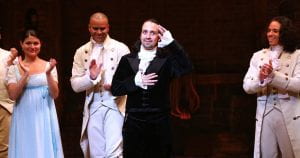By: Adair Garrett
I believe that his many of Hamilton’s missteps throughout the musical are caused by Hamilton’s inability to step out of himself and examine his own impulses. Miranda’s protagonist shows ambition in almost every song of the play, but this determination causes him to be blind to the desires of other people. Impulsiveness undercuts his morality, and the most stark example of this in the musical is the moment Hamilton sleeps with a woman who is not his wife.
The callback to “Helpless” in both the song “Satisfied” and the song “Say No to This” leaves the audience with a sense that Hamilton only makes major decisions concerning women completely based on what is most convenient for himself at the time. The first time we hear the tune and idea of “Helpless”, we see Hamilton and Eliza falling in love. The second time comes immediately after the first, as the song “Satisfied” undercuts the magic of the moment by providing a complete juxtaposition to the initial perspective. Although Angelica is shown to be Hamilton’s intellectual equal, he chooses to be with Eliza because she is more appealing to him in the moment. As the story is retold from Angelica’s perspective, we get the feeling that Angelica is omnipotent and that Hamilton makes a mistake by making a decision so quickly. Another callback to “Helpless” returns when Hamilton meets Maria Reynolds, leading the audience to understand that Hamilton makes the decision on the same impulse that led him to marry Eliza. Hamilton cannot acknowledge that he must make the decision to sacrifice short term happiness for long term fulfillment, and this stubborn ignorance ultimately causes his early demise.
His affair with Maria Reynolds was the ultimate example of his constant desire for instant gratification and proved how willingly he would sacrifice the love of his family for short term happiness. Even if he had not had sex with Maria, the fact that he wasn’t wary of her upon her first fliration shows that he is not able to deny his impulsive wants. Hamilton’s personality dictated his fate with Maria long before he met her, although he cannot declare the fault to be his own. In the song “Say No to This”, Hamilton displaces his own agency and removes the blame from himself by placing it onto the woman, another decision that makes his life more convenient for himself by sacrificing the good of someone else. He even displaces his own agency during the song by asking for divine interference to get him out of the situation, as if he cannot control himself so God must show him the answer.
In “Burn”, Eliza finally addresses Hamilton’s major faults. She addresses that fact that Hamilton’s decisions are often driven by his desire for instant gratification; she tells him he’s “obsessed with [his] legacy”. This obsession causes him to choose glory over his family and often over decisions that would have more lasting effects on American history. Eliza tells him for the first time about a doubt placed into her mind by her sister back in 1781, again reiterating the idea that Angelica has been omnipotent throughout the musical. Eliza kicks him out of their bed, a symbol for their marriage, after telling him how betrayed she felt when she found out another girl had slept in their bed. This is our first example of a punishment for Hamilton’s lack of empathy and foresight where Hamilton sees no easy way out. She finally burns all the letters, which is a permanent decision that she makes to destroy all of Hamilton’s buttery words and force his name to be tied with the affair instead of their loving marriage.
Nevertheless, had Hamilton had more time, he probably would have thought better of making such impulsive decisions in his relationships with women. Carrie Underwood says it better than I can:





